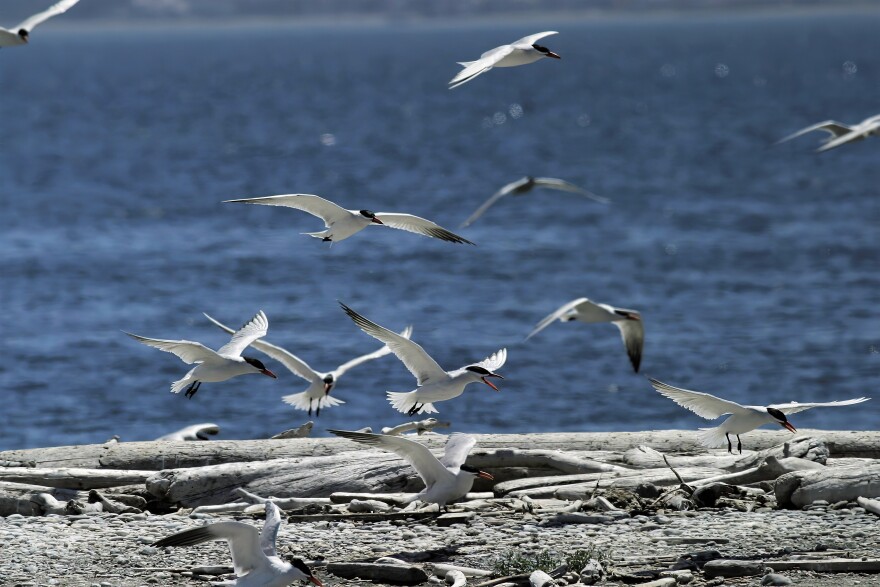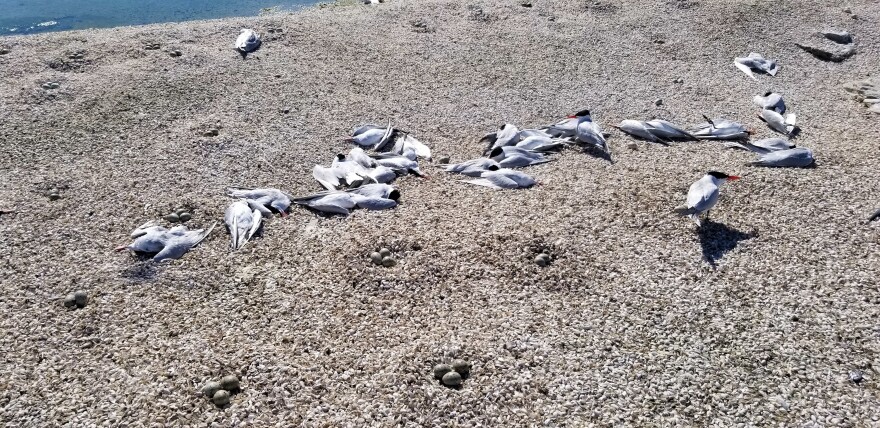Wildlife biologists are finding whole colonies of birds dead or dying on islands in Lake Michigan. They's Caspian terns, which are listed as threatened in Michigan and endangered in Wisconsin.
“Caspian terns are magnificent birds. They've got that striking black cap and they fly along, looking down at the water while they fly and then suddenly plunge into the water to catch fish. They're exciting to watch,” said Lisa Williams, a contaminants specialist with the U.S. Fish and Wildlife Service.
In recent years, the bird’s population has been growing. In 2018 it peaked at about 10,000 Caspian terns in the Great Lakes region. Then high water levels made nesting difficult for the birds.
Now it appears that Highly Pathogenic Avian Influenza — bird flu — is killing hundreds and hundreds of the birds.

“Caspian terns nest very close together. And for a disease that's transmitted through the air, they're in close enough proximity that that can happen fairly readily on their colonies,” Williams explained.
The result is at least 1,476 adult terns dead on Lake Michigan islands.
Sumner Matteson is an avian ecologist with the Wisconsin Department of Natural Resources. He said what he found on an island off of Wisconsin’s Door Peninsula was horrific.
“Seeing hundreds of dead birds scattered in a line before you with others dying among those. And it's a — it's a feeling of helplessness, knowing that there's nothing, absolutely nothing, you can do for those birds.”
Sumner said he’s never seen anything so traumatic in his 42 years on the job.
On other islands near the Door Peninsula, more birds were found dead. Sadie O’Dell is a wildlife biologist at the Gravel Island National Wildlife Refuge. She said those birds that were still alive could barely hold their heads up. They were experiencing tremors from the neurological damage caused by the bird flu virus. Some of the birds were on their nests, still trying to incubate eggs when they died.

Matteson said at this point, as estimated 64% of the adult Caspian terns in Wisconsin are dead.
“Absolutely devastating. Catastrophic. It's going to take years for the Wisconsin population to recover,” he said — and after thinking about it, he decided it would more likely take decades.
In Michigan, on Bellow Island in the Grand Traverse Bay, another scientist discovered colonies that were wiped out. Jim Ludwig is an environmental consultant who’s studied birds in the Great Lakes for decades. He monitors birds such as the Caspian tern.
“Last count, prior to the time we were out there, was 201 nests, and we found 255 dead adults,” he said.
Likely more than that died elsewhere. Some might have died somewhere out in Lake Michigan. Scavengers might have carried off some of the others.
Francie Cuthbert is a professor with the University of Minnesota’s Department of Fisheries, Wildlife and Conservation Biology. She said these massive die-offs also mean the loss of a new generation of Caspian terns.
“No young are being produced. And then the loss of all of these adults is serious.”
These large terns can live about 30 years. They don’t start breeding until they’re at least three years old.
“Losing all these older, experienced breeders is also very important because they tend to increase in terms of their productivity and just their knowledge of how to raise young,” Cuthbert explained.

Why Caspian terns are being hit so hard by avian influenza, but other close-nesting seabirds have not experienced the same kind of devastation, is baffling to the scientists. There have been deaths among ring-billed gulls, pelicans, and others, but not at the rate of Caspian tern deaths with one exception, double-crested cormorants.
Cuthbert said it’s hard to say how critical this will be to the future of the bird.
“Until we really have a full tally on how many birds have died, we're not going to be able to model the impact on the population, but it's definitely going to have a deep drop.”
Lisa Williams with the U.S. Fish and Wildlife Service says the numbers definitely could go higher.
“The researchers that discovered this are visiting other colonies this week and will definitely be on the lookout, particularly at places where Caspian terns have nested in the past.”
It might be a while before wildlife officials can determine just how badly the avian flu has hit the Caspian tern population. It’s unclear what, if anything, can be done to help the birds.
Copyright 2022 Michigan Radio. To see more, visit Michigan Radio. 9(MDEyMzg0OTk0MDEzODE1MjM2ODE2ODgyMg004))


